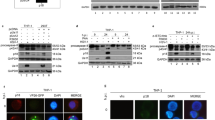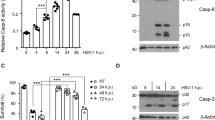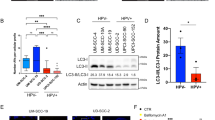Abstract
Herpes simplex virus type 1 (HSV-1) is one of the most widely studied viruses for oncolytic virotherapy. In squamous cell carcinoma (SCC) cells, the role of autophagy induced by neurovirulence gene-deficient HSV-1s in programmed cell death has not yet been elucidated. The oncolytic HSV-1 strain RH2, which lacks the γ34.5 gene and induces the fusion of human SCC cells, was used. RH2 replicated and induced cell death in SCC cells. RH2 infection was accompanied by the aggregation of microtubule-associated protein 1 light chain 3 (LC3) in the cytoplasm, the conversion of LC3-I to LC3-II and the formation of double-membrane vacuoles containing cell contents. No significant changes were observed in the expression of Bcl-2 or Bax, while a slight decrease was observed in that of Beclin 1. The autophagy inhibitors, 3-methyladenine (3-MA) and bafilomycin A1, did not affect viral replication, but significantly inhibited the cytotoxicity of RH2. The caspase-3 inhibitor z-DEVD-fmk and caspase-1 inhibitor z-YVAD-fmk also reduced the cytotoxicity of RH2. These results demonstrated that γ34.5 gene-deficient HSV-1 RH2 induced autophagic cell death in SCC cells as well as pyroptosis and apoptosis.
This is a preview of subscription content, access via your institution
Access options






Similar content being viewed by others
References
Buijs PR, Verhagen JH, van Eijck CH, van den Hoogen BG . Oncolytic viruses: from bench to bedside with a focus on safety. Hum Vaccine Immunother 2015; 11: 1573–1584.
Vähä-Koskela MJ, Heikkilä JE, Hinkkanen AE . Oncolytic viruses in cancer therapy. Cancer Lett 2007; 254: 178–216.
Russell SJ, Peng KW, Bell JC . Oncolytic virotherapy. Nat Biotechnol 2012; 30: 658–670.
Harrington KJ, Hingorani M, Tanay MA, Hickey J, Bhide SA, Clarke PM et al. Phase I/II study of oncolytic HSV GM-CSF in combination with radiotherapy and cisplatin in untreated stage III/IV squamous cell cancer of the head and neck. Clin Cancer Res 2010; 16: 4005–4015.
Andtbacka RH, Kaufman HL, Collichio F, Amatruda T, Senzer N, Chesney J et al. Talimogene laherparepvec improves durable response rate in patients with advanced melanoma. J Clin Oncol 2015; 33: 2780–2788.
Yura Y, Hamada M . Development of oncolytic virothearpy for the treatment of oral cancer -At the waiting stage for clinical use. Oral Sci Int 2017; 14: 1–12.
Pol J, Kroemer G, Galluzzi L . First oncolytic virus approved for melanoma immunotherapy. Oncoimmunology 2015; 5: e1115641.
Kroemer G, Mariño G, Levine B . Autophagy and the integrated stress response. Mol Cell 2010; 40: 280–293.
Mizushima N, Yoshimori T, Levine B . Methods in mammalian autophagy research. Cell 2010; 140: 313–326.
Yang Z, Klionsky DJ . Mammalian autophagy: core molecular machinery and signaling regulation. Curr Opin Cell Biol 2010; 22: 124–131.
McFarlane S, Aitken J, Sutherland JS, Nicholl MJ, Preston VG, Preston CM . Early induction of autophagy in human fibroblasts after infection with human cytomegalovirus or herpes simplex virus 1. J Virol 2011; 85: 4212–4221.
Kondo Y, Kanzawa T, Sawaya R, Kondo S . The role of autophagy in cancer development and response to therapy. Nat Rev Cancer 2005; 5: 726–734.
Turcotte S, Giaccia AJ . Targeting cancer cells through autophagy for anticancer therapy. Curr Opin Cell Biol 2010; 22: 246–251.
Lamkanfi M, Dixit VM . Manipulation of host cell death pathways during microbial infections. Cell Host Microbe 2010; 8: 44–54.
Guo ZS, Liu Z, Bartlett DL . Oncolytic immunotherapy: dying the right way is a key to eliciting potent antitumor immunity. Front Oncol 2014; 4: 74.
Orvedahl A, Alexander D, Tallóczy Z, Sun Q, Wei Y, Zhang W et al. HSV-1 ICP34.5 confers neurovirulence by targeting the Beclin 1 autophagy protein. Cell Host Microbe 2007; 1: 23–35.
Schmid D, Münz C . Innate and adaptive immunity through autophagy. Immunity 2007; 27: 11–21.
Kudchodkar SB, Levine B . Viruses and autophagy. Rev Med Virol 2009; 19: 359–378.
Chou J, Kern ER, Whitley RJ, Roizman B . Mapping of herpes simplex virus-1 neurovirulence to gamma 134.5, a gene nonessential for growth in culture. Science 1990; 250: 1262–1266.
He B, Gross M, Roizman B . The gamma(1)34.5 protein of herpes simplex virus 1 complexes with protein phosphatase 1alpha to dephosphorylate the alpha subunit of the eukaryotic translation initiation factor 2 and preclude the shutoff of protein synthesis by double-stranded RNA-activated protein kinase. Proc Natl Acad Sci USA 1997; 94: 843–848.
Tallóczy Z, Jiang W, Virgin HW 4th, Leib DA, Scheuner D, Kaufman RJ et al. Regulation of starvation- and virus-induced autophagy by the eIF2alpha kinase signaling pathway. Proc Natl Acad Sci USA 2002; 99: 190–195.
Tovilovic G, Ristic B, Siljic M, Nikolic V, Kravic-Stevovic T, Dulovic M et al. mTOR-independent autophagy counteracts apoptosis in herpes simplex virus type 1-infected U251 glioma cells. Microbes Infect 2013; 15: 615–624.
Yordy B, Iwasaki A . Cell type-dependent requirement of autophagy in HSV-1 antiviral defense. Autophagy 2013; 9: 236–138.
Petrovski G, Pasztor K, Orosz L, Albert R, Mencel E, Moe MC et al. Herpes simplex virus types 1 and 2 modulate autophagy in SIRC corneal cells. J Biosci 2014; 39: 683–692.
Yakoub AM, Shukla D . Herpes simplex virus-1 fine-tunes host’s autophagic response to infection: a comprehensive analysis in productive infection models. PLoS ONE 2015; 10: e0124646.
Yakoub AM, Shukla D . Autophagy stimulation abrogates herpes simplex virus-1 infection. Sci Rep 2015; 5: 9730.
Andreansky S, Soroceanu L, Flotte ER, Chou J, Markert JM, Gillespie GY et al. Evaluation of genetically engineered herpes simplex viruses as oncolytic agents for human malignant brain tumors. Cancer Res 1997; 57: 1502–1509.
Liu BL, Robinson M, Han ZQ, Branston RH, English C, Reay P et al. ICP34.5 deleted herpes simplex virus with enhanced oncolytic, immune stimulating, and anti-tumour properties. Gene Ther 2003; 10: 292–303.
Campadelli-Fiume G, De Giovanni C, Gatta V, Nanni P, Lollini PL, Menotti L . Rethinking herpes simplex virus: the way to oncolytic agents. Rev Med Virol 2011; 21: 213–226.
Takaoka H, Takahashi G, Ogawa F, Imai T, Iwai S, Yura Y . A novel fusogenic herpes simplex virus for oncolytic virotherapy of squamous cell carcinoma. Virol J 2011; 8: 294.
Takahashi G, Meshii N, Hamada M, Iwai S, Yura Y . Sequence of a fusogenic herpes simplex virus, RH2, for oncolytic virotherapy. J Gen Virol 2013; 94: 726–737.
Meshii N, Takahashi G, Okunaga S, Hamada M, Iwai S, Takasu A et al. Enhancement of systemic tumor immunity for squamous cell carcinoma cells by an oncolytic herpes simplex virus. Cancer Gene Ther 2013; 20: 493–498.
Takasu A, Masui A, Hamada M, Imai T, Iwai S, Yura Y . Immunogenic cell death by oncolytic herpes simplex virus type 1 in squamous cell carcinoma cells. Cancer Gene Ther 2016; 23: 107–113.
Liang XH, Kleeman LK, Jiang HH, Gordon G, Goldman JE, Berry G et al. Protection against fatal Sindbis virus encephalitis by beclin, a novel Bcl-2-interacting protein. J Virol 1998; 72: 8586–8596.
Shimizu S, Kanaseki T, Mizushima N, Mizuta T, Arakawa-Kobayashi S, Thompson CB et al. Role of Bcl-2 family proteins in a non-apoptotic programmed cell death dependent on autophagy genes. Nat Cell Biol 2004; 6: 1221–1228.
Benetti L, Munger J, Roizman B . The herpes simplex virus 1 US3 protein kinase blocks caspase-dependent double cleavage and activation of the proapoptotic protein BAD. J Virol 2003; 77: 6567–6573.
Kraft RM, Nguyen ML, Yang XH, Thor AD, Blaho JA . Caspase 3 activation during herpes simplex virus 1 infection. Virus Res 2006; 120: 163–175.
Lotfi K, Zackrisson AL, Peterson C . Comparison of idarubicin and daunorubicin regarding intracellular uptake, induction of apoptosis, and resistance. Cancer Lett 2002; 178: 141–149.
Colunga AG, Laing JM, Aurelian L . The HSV-2 mutant DeltaPK induces melanoma oncolysis through nonredundant death programs and associated with autophagy and pyroptosis proteins. Gene Ther 2010; 17: 315–327.
Farassati F, Yang AD, Lee PW . Oncogenes in Ras signalling pathway dictate host-cell permissiveness to herpes simplex virus 1. Nat Cell Biol 2001; 3: 745–750.
Smith KD, Mezhir JJ, Bickenbach K, Veerapong J, Charron J, Posner MC et al. Activated MEK suppresses activation of PKR and enables efficient replication and in vivo oncolysis by Deltagamma(1)34.5 mutants of herpes simplex virus 1. J Virol 2006; 80: 1110–1120.
Alexander DE, Ward SL, Mizushima N, Levine B, Leib DA . Analysis of the role of autophagy in replication of herpes simplex virus in cell culture. J Virol 2007; 81: 12128–12134.
Kanai R, Zaupa C, Sgubin D, Antoszczyk SJ, Martuza RL, Wakimoto H et al. Effect of γ34.5 deletions on oncolytic herpes simplex virus activity in brain tumors. J Virol 2012; 86: 4420–4431.
Peri P, Nuutila K, Vuorinen T, Saukko P, Hukkanen V . Cathepsins are involved in virus-induced cell death in ICP4 and Us3 deletion mutant herpes simplex virus type 1-infected monocytic cells. J Gen Virol 2011; 92: 173–180.
Guo H, Kaiser WJ, Mocarski ES . Manipulation of apoptosis and necroptosis signaling by herpesviruses. Med Microbiol Immunol 2015; 204: 439–448.
Endo Y, Sakai R, Ouchi M, Onimatsu H, Hioki M, Kagawa S et al. Virus-mediated oncolysis induces danger signal and stimulates cytotoxic T-lymphocyte activity via proteasome activator upregulation. Oncogene 2008; 27: 2375–2381.
Thorburn J, Horita H, Redzic J, Hansen K, Frankel AE, Thorburn A . Autophagy regulates selective HMGB1 release in tumor cells that are destined to die. Cell Death Differ 2009; 16: 175–183.
Michaud M, Martins I, Sukkurwala AQ, Adjemian S, Ma Y, Pellegatti P et al. Autophagy-dependent anticancer immune responses induced by chemotherapeutic agents in mice. Science 2011; 334: 1573–1577.
Dengjel J, Schoor O, Fischer R, Reich M, Kraus M, Müller M et al. Autophagy promotes MHC class II presentation of peptides from intracellular source proteins. Proc Natl Acad Sci USA 2005; 102: 7922–7927.
Maiuri MC, Le Toumelin G, Criollo A, Rain JC, Gautier F, Juin P et al. Functional and physical interaction between Bcl-X(L) and a BH3-like domain in Beclin-1. EMBO J 2007; 26: 2527–2539.
Scorrano L, Korsmeyer SJ . Mechanisms of cytochrome c release by proapoptotic BCL-2 family members. Biochem Biophys Res Commun 2003; 304: 437–444.
Jiang H, White EJ, Ríos-Vicil CI, Xu J, Gomez-Manzano C, Fueyo J . Human adenovirus type 5 induces cell lysis through autophagy and autophagy-triggered caspase activity. J Virol 2011; 85: 4720–4729.
Yokoyama T, Iwado E, Kondo Y, Aoki H, Hayashi Y, Georgescu MM et al. Autophagy-inducing agents augment the antitumor effect of telomerase-selective oncolytic adenovirus OBP-405 on glioblastoma cells. Gene Ther 2008; 15: 1233–1239.
Acknowledgements
We thank Dr Shintaro Kira for his advice on flow cytometry. This research was supported by a Grant-in-Aid for Scientific Research from the Ministry of Education, Science and Culture of Japan (No. 24390453).
Author information
Authors and Affiliations
Corresponding author
Ethics declarations
Competing interests
The authors declare no conflict of interest.
Rights and permissions
About this article
Cite this article
Furukawa, Y., Takasu, A. & Yura, Y. Role of autophagy in oncolytic herpes simplex virus type 1-induced cell death in squamous cell carcinoma cells. Cancer Gene Ther 24, 393–400 (2017). https://doi.org/10.1038/cgt.2017.33
Received:
Accepted:
Published:
Issue Date:
DOI: https://doi.org/10.1038/cgt.2017.33
This article is cited by
-
Oncolytic virotherapy: basic principles, recent advances and future directions
Signal Transduction and Targeted Therapy (2023)



